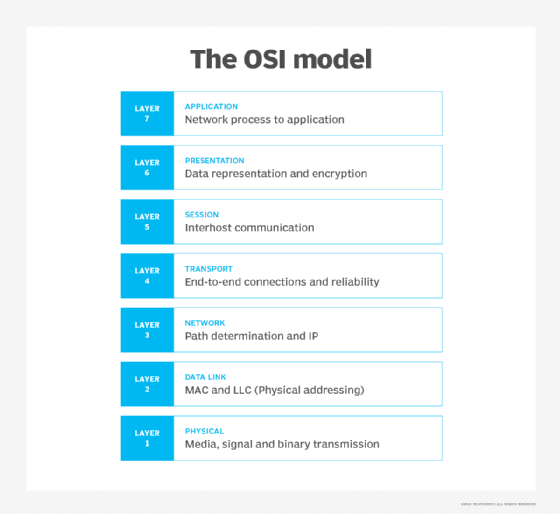OSI (Open Systems Interconnection) is a reference model for how applications communicate over a network.
A reference model is a conceptual framework for understanding relationships. The purpose of the OSI reference model is to guide vendors and developers so the digital communication products and software programs they create can interoperate, and to facilitate a clear framework that describes the functions of a networking or telecommunication system.
OSI model layers
The main concept of OSI is that the process of communication between two endpoints in a network can be divided into seven distinct groups of related functions, or layers. Each communicating user or program is on a device that can provide those seven layers of function.
In this architecture, each layer serves the layer above it and, in turn, is served by the layer below it. So, in a given message between users, there will be a flow of data down through the layers in the source computer, across the network, and then up through the layers in the receiving computer.

The seven layers of function are provided by a combination of applications, operating systems, network card device drivers and networking hardware that enable a system to transmit a signal over a network Ethernet or fiber optic cable or through Wi-Fi or other wireless protocols.
The seven Open Systems Interconnection layers are:
Layer 7: The application layer. This is the layer at which communication partners are identified -- Is there someone to talk to? -- network capacity is assessed -- Will the network let me talk to them right now? -- and where the data or application is presented in a visual form the user can understand. This layer is not the application itself, it is the set of services an application should be able to make use of directly, although some applications may perform application-layer functions.
Layer 6: The presentation layer. This layer is usually part of an operating system (OS) and converts incoming and outgoing data from one presentation format to another -- for example, from clear text to encrypted text at one end and back to clear text at the other.
Layer 5: The session layer. This layer sets up, coordinates and terminates conversations. Its services include authentication and reconnection after an interruption. On the internet, Transmission Control Protocol (TCP) and User Datagram Protocol (UDP) provide these services for most applications.
Layer 4: The transport layer. This layer manages packetization of data, then the delivery of the packets, including checking for errors in the data once it arrives. On the internet, TCP and UDP provide these services for most applications as well.
Layer 3: The network layer. This layer handles addressing and routing the data -- sending it in the right direction to the right destination on outgoing transmissions and receiving incoming transmissions at the packet level. IP is the network layer for the internet.
Layer 2: The data-link layer. This layer sets up links across the physical network, putting packets into network frames. This layer has two sub-layers: the logical link control layer and the media access control layer (MAC). MAC layer types include Ethernet and 802.11 wireless specifications.
Layer 1: The physical layer. This layer conveys the bit stream across the network either electrically, mechanically or through radio waves. The physical layer covers a variety of devices and mediums, among them cabling, connectors, receivers, transceivers and repeaters.









0 comments:
Post a Comment